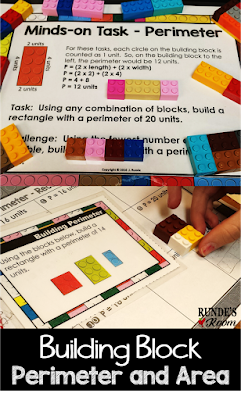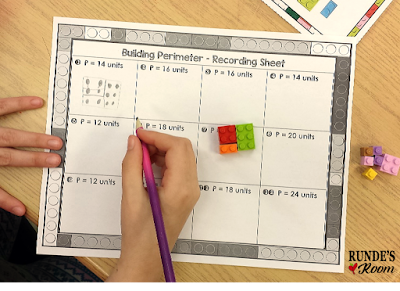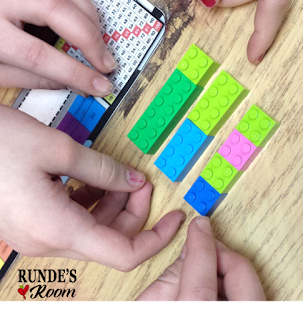And perfect it was. My class NEEDS that hands-on exploration - every class really does, but I've found that this one needs it just a little bit more. They were so excited to learn the concepts this way - and couldn't believe they were getting to use "toys" in math. Doesn't get much better than that. So, "Building Block Math" was born.
We started out with a minilesson through a Minds-On Task. I just projected the Minds-On page under the document camera for students to see. We went through how to find perimeter and area with the building blocks (counting each raised circle as one unit), and I reminded my students about the formulas (perimeter and area of rectangles aren't new concepts for my 4th and 5th grade students, but digging deeper into comparing perimeter and area is). I then let the students work in pairs to complete the task and challenge task on the page. As each pair finished, they could come up and place their blocks right on the page so their work was projected for all to see (they LOVE this). (Note - We covered the perimeter resource first before we moved onto area).
 Following the minds-on task, students were allowed to continue working with their partner (but you could easily do this as a math center or station, or an independent task) to complete the 12 task cards for each concept. The task cards have the students building the different rectangles (or irregular polygons - there are 2 cards for this) with the required perimeter or area using all the blocks shown on each card (the color of the block doesn't matter, just the size). This was so fun because it was such a brain challenge - requiring students to put the pieces together like a puzzle so that they could get the correct answer. Each resource has a recording sheet for the students to draw their answers on, as well as an answer sheet. The answer sheet could be used at the math station for students to self-check their answers, or students can hand in their completed recording sheets for a formative assessment for you.
Following the minds-on task, students were allowed to continue working with their partner (but you could easily do this as a math center or station, or an independent task) to complete the 12 task cards for each concept. The task cards have the students building the different rectangles (or irregular polygons - there are 2 cards for this) with the required perimeter or area using all the blocks shown on each card (the color of the block doesn't matter, just the size). This was so fun because it was such a brain challenge - requiring students to put the pieces together like a puzzle so that they could get the correct answer. Each resource has a recording sheet for the students to draw their answers on, as well as an answer sheet. The answer sheet could be used at the math station for students to self-check their answers, or students can hand in their completed recording sheets for a formative assessment for you. We've just finished up both perimeter and area resources, and next week (after our Spring Break - yay!) we'll dive into Comparing Perimeter and Area. This resource really gets students thinking as they are asked to build all rectangles with a certain perimeter and different areas, or all rectangles with a certain area and different perimeters - and then compare the "shapes" of the rectangles.
We've just finished up both perimeter and area resources, and next week (after our Spring Break - yay!) we'll dive into Comparing Perimeter and Area. This resource really gets students thinking as they are asked to build all rectangles with a certain perimeter and different areas, or all rectangles with a certain area and different perimeters - and then compare the "shapes" of the rectangles. I only bought one standard box of these building blocks for the students - and there are more than enough pieces in the box for all the students in the class to work with (I'll include an affiliate link to the box I got below). For super easy prep, I just put the whole box in a central location in the classroom. Students grabbed a handful before they started working, and if they needed more or different pieces, they just got up to get some more. You could bag up some of the pieces for each pair to use before hand, but this was quicker and easier, and got the students up and moving a little more, instead of just sitting at their seats (again, something my class needs a little more of this year).
If you're interested, you can check out these resources through the links below.































Did you find they one medium box of Legos was enough? (Approximately 400+ pieces)
ReplyDelete